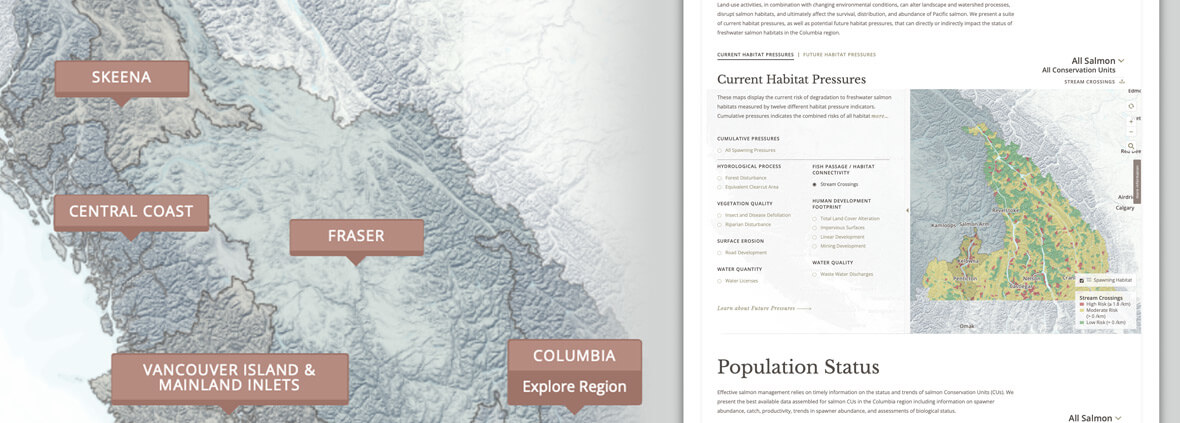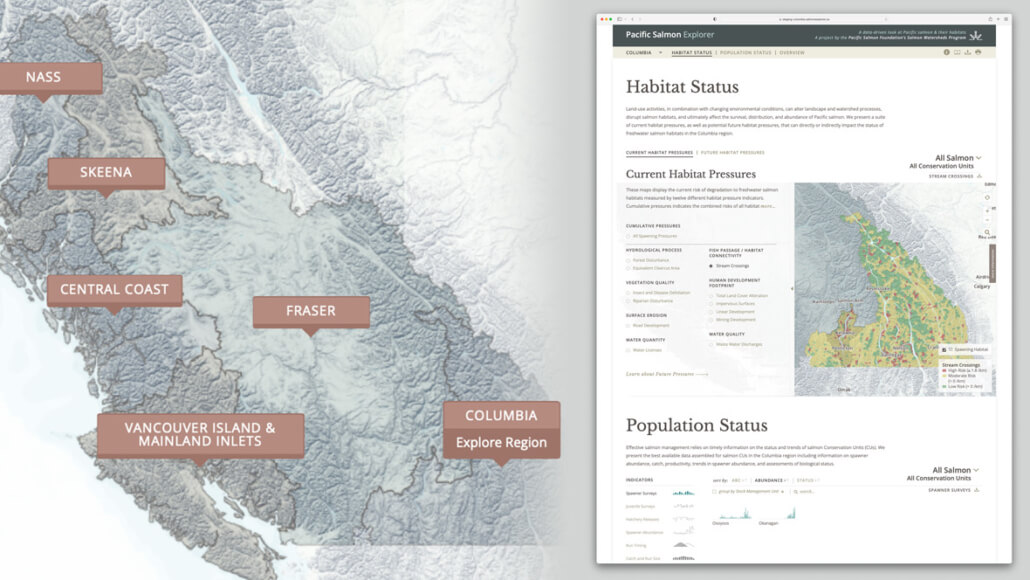Columbia River salmon data now available in the Pacific Salmon Explorer
The best publicly-available data for Pacific salmon in the Columbia River watershed is now available in the Pacific Salmon Explorer, an online data visualization tool developed by the Pacific Salmon Foundation’s (PSF) Salmon Watersheds Program, which now includes data on 90 per cent of salmon in B.C. The addition of the Columbia to the Pacific Salmon Explorer provides a snapshot of local salmon populations and current human and environmental pressures on their freshwater habitats.
Salmon once thrived in the Canadian portion of the Columbia River watershed. However, as a result of nearly a century of human development, most notably dam construction, salmon can no longer access spawning habitat in most of the region. Over the past decade, collaborative stewardship efforts have catalyzed impressive returns to the Okanagan River, a tributary of the Columbia. As data in the Pacific Salmon Explorer demonstrates, Okanagan sockeye are experiencing year-over-year improvements in the number of returning adult salmon thanks to dedicated recovery efforts of local organizations such as the Okanagan Nation Alliance.
“Our update to the Pacific Salmon Explorer includes the addition of the two remaining salmon Conservation Units salmon found in the Canadian portion of the Columbia River watershed. With this update, the Pacific Salmon Explorer now provides access to the most up-to-date information on spawner abundance, hatchery releases, run timing, biological status and trends, and habitat pressures,” said Vesta Mather, Salmon Watersheds Program project manager.
This work was made possible through the generous expertise and input shared by local knowledge holders and groups undertaking focused work in the region including the Okanagan Nation Alliance, Shuswap Indian Band, Ktunaxa Nation Council, Living Lakes Canada, Okanagan Basin Waterboard, Okanagan Fisheries Foundation, the Department of Fisheries and Oceans, the Province of British Columbia, and others.
“Expertise from these groups and their extensive work with sockeye and Chinook allowed us to identify specific spawning locations that informed the habitat assessments,” said Dr. Katrina Connors, director of the Salmon Watersheds Program. “Local knowledge is a critical part of these habitat assessments and for improving our collective understanding of how current habitat pressures may be affecting the recovery of local salmon populations. With the addition of the Columbia, PSF is one step closer toward its goal of democratizing access to information on the state of salmon and their habitats in B.C.”
Key facts about the Columbia addition to the Pacific Salmon Explorer
- With the inclusion of the Columbia region, the Pacific Salmon Explorer now provides access to salmon data for seven of the eight salmon-bearing regions identified for B.C.
- The addition of the Columbia region to the Pacific Salmon Explorer highlights key findings. For example, sockeye salmon in the Okanagan have seen significant improvements in average escapement over the last decade. The data also shows that 100 per cent of existing Chinook spawning habitats and 92 per cent of existing sockeye spawning habitats in the watershed face a high risk of habitat degradation due to extensive road development.
- Historically, the entire Columbia River watershed had thriving salmon populations. However, beginning in the 1930s, dam construction throughout the watershed had dramatic impacts on distribution, either increasing the challenges salmon face during their migration or cutting salmon off from their freshwater habitats entirely. In the case of dams on the Columbia River without fish passage, salmon no longer return to the majority of the Canadian portion of the Columbia watershed. The Okanagan system is still accessible, but salmon were still nearly extirpated from the region. Over the past decade, stewardship efforts led by the Okanagan Nation Alliance and others have catalyzed an impressive return to the region.
- Salmon face many pressures on their freshwater habitats due to a combination of human (e.g. forestry, water use, etc.) and environmental pressures (e.g. insect and diseases). For example, even after successfully passing many major dams twice in their life cycle, salmon which return to spawn are under continued habitat pressures, with some of the top risks in the Okanagan being road development, water withdrawals, and riparian disturbance. While efforts to return channels to a more natural state have had positive impacts, the highly developed state of the region will be an ongoing challenge.
- Engagement with local salmon experts was critical to the success of this process. PSF collaborated with representatives from First Nations, conservation organizations, and local experts — who shared knowledge and important local research — to better identify spawning salmon distribution in the Okanagan. This exercise identified spawning distributions (more than 8,000 square kilometres spawning Zone of Influence (ZOI) surrounding 65 total linear kilometres of spawning distribution) not previously identified in provincial or federal databases. PSF hopes to support other salmon recovery initiatives in the Columbia region with this data. For example, the Indigenous-led Columbia River Salmon Reintroduction Initiative (CRSRI) may be able to use habitat pressure assessment in the currently non-salmon-bearing portions of the watershed to inform restoration planning.
ABOUT THE PACIFIC SALMON EXPLORER: the Pacific Salmon Explorer – is one of the most comprehensive sources of information on salmon in B.C., with data and assessments for 90 per cent of salmon across the province. The Pacific Salmon Foundation’s Salmon Watersheds Program has been collaborating with First Nations, federal and provincial governments, academics, NGOs, and independent salmon experts for more than a decade to identify, assemble, analyze, and present the best available data for salmon in B.C. Recent updates to the Pacific Salmon Explorer are a huge boost for this mission as it now includes salmon across almost all of B.C, with only the northern Transboundary region in progress.




 Amy Romer
Amy Romer